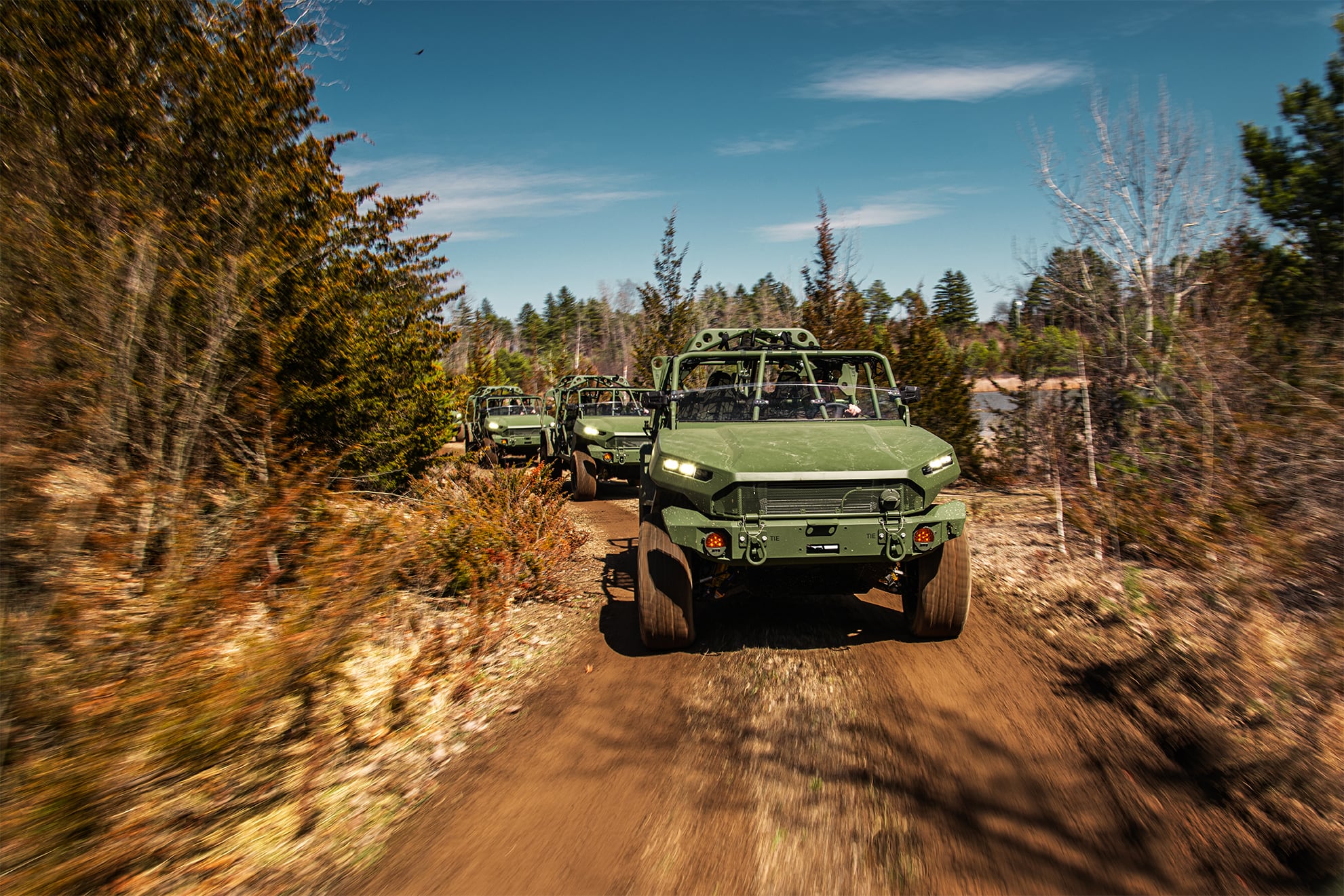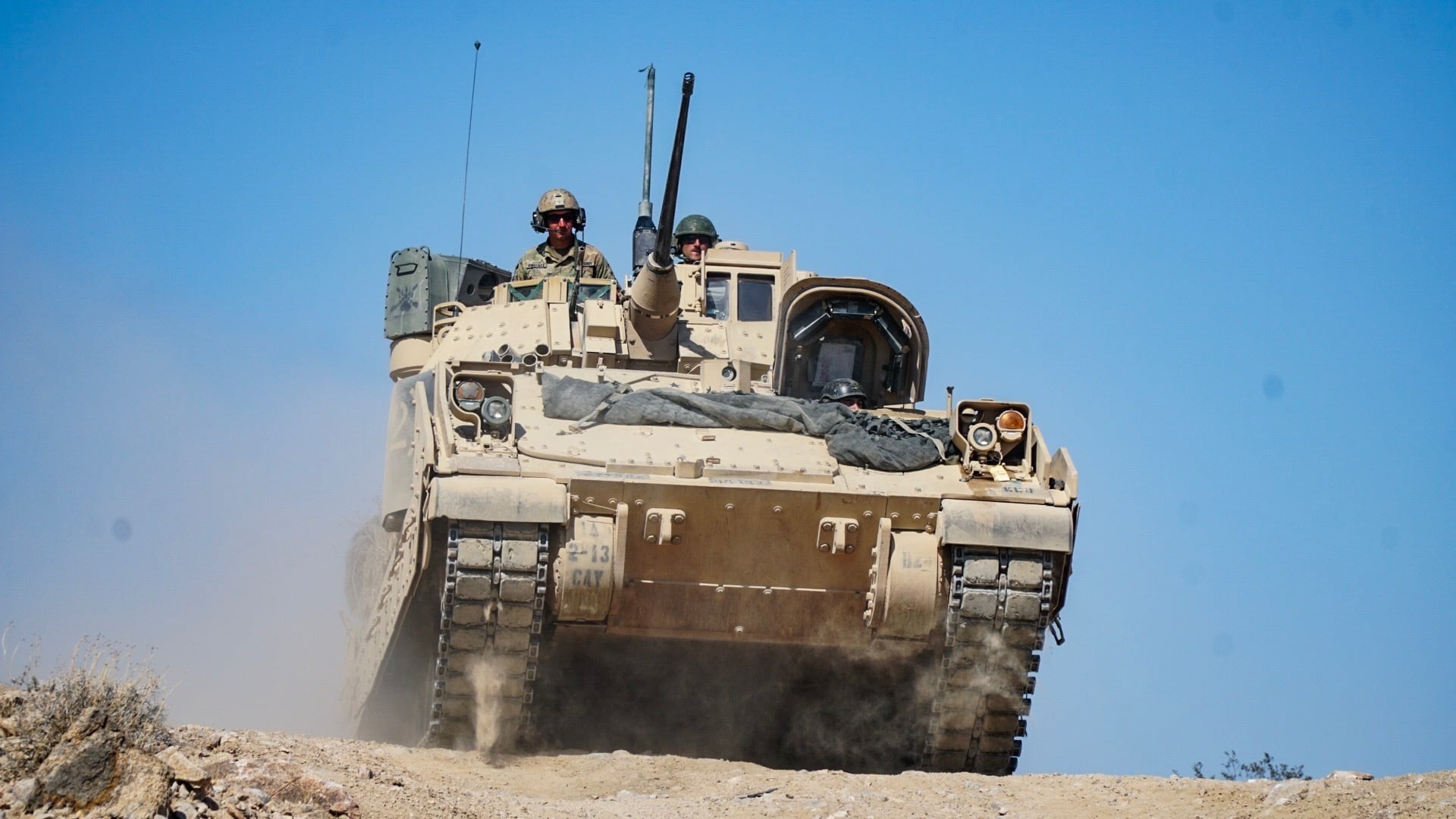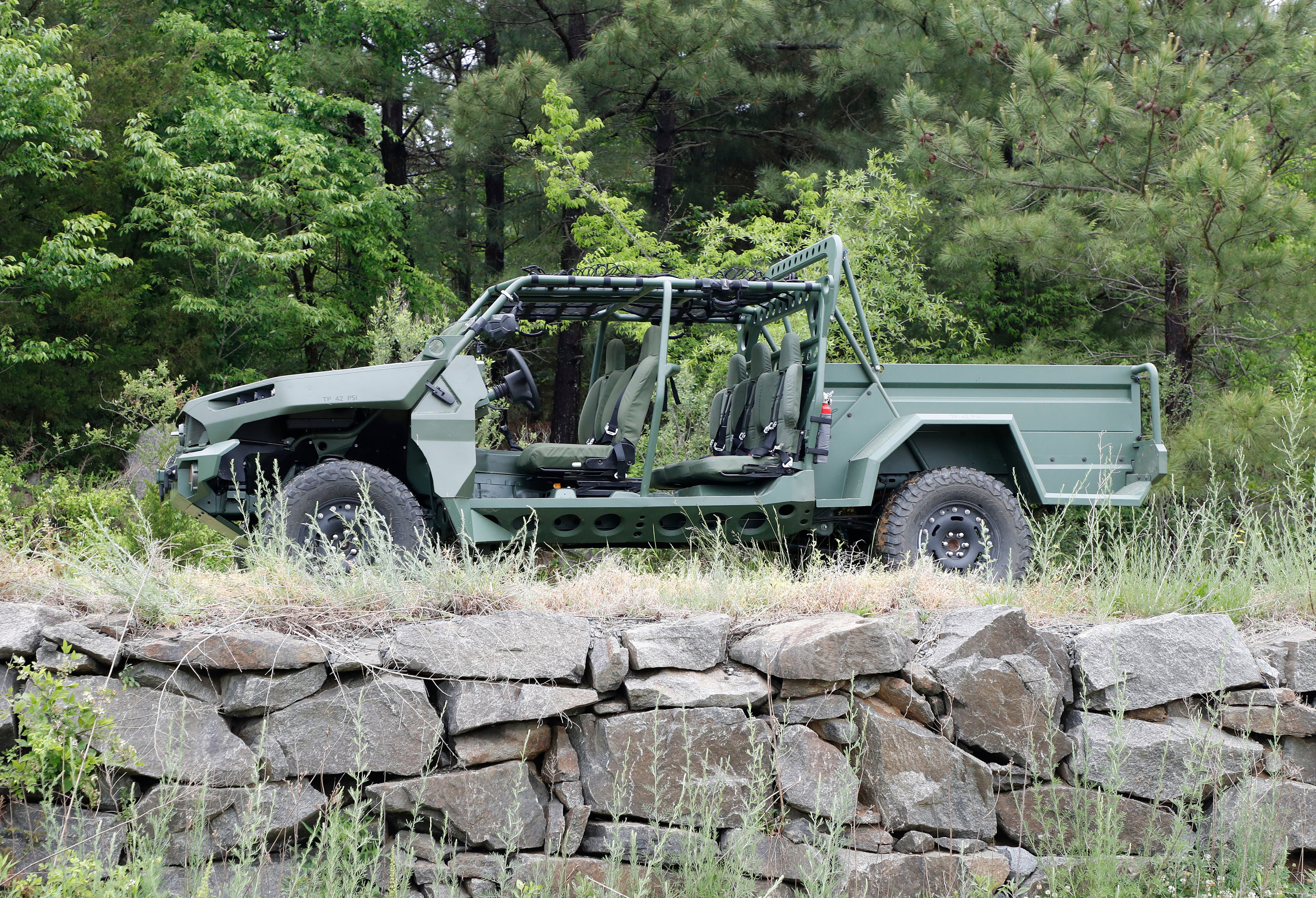MILFORD, Mich. — The U.S. Army is wading into the murky waters of fielding electric vehicles, and industry stands ready to make that happen, but it’s been difficult for the experienced commercial world to convince the hesitant service to take the plunge.
For the last several years, the Army ramped up efforts to strategize a potential transition away from classic fuels like JP-8 to power its vehicles, allowing industry to bring working vehicles to demonstrate what is possible today and in the future.
But there is still little funding applied to efforts to find alternative fuel to power its current and future combat and tactical vehicle fleets.
At the beginning of June, GM Defense, whose parent company General Motors is a global leader in commercial electric vehicles, hosted Army officials at its Milford Proving Grounds in Michigan. The service officials drove the new U.S. Army Infantry Squad Vehicle — produced by GM Defense — through an off-road course, climbing steep, rocky inclines, zipping around tight corners, and rumbling over gravel and plowing through mud. Then they traded that for a fully electric version to consider the performance differences.
When it comes to combat vehicles like Abrams tanks, Stryker combat vehicles and Bradley Infantry Fighting Vehicles, “I’m not sure we’re going fully electric any time soon,” Brig. Gen. Glenn Dean, the program executive officer for ground combat systems, told Defense News in an interview in Warren, about a 50-minute drive from GM’s proving ground.
“Maybe for robotic platforms. That might be the first case,” he said, “because it’s about size and weight. If you took the amount of batteries with current technology that you would need to move an Abrams tank purely electrically, it’s bigger than the tank, so we have a packaging and storage problem when it comes to pure electric.”
Interested in how energy and the environment impact military operations? Click here for more.
Dean said the Army might initially prefer a hybrid power option. “We’ve looked at that every couple of years. The question is: Are we there yet? I suspect we may be at the point where hybrid electric is probably there. You’re certainly seeing it broadly enough in the commercial space that there’s probably enough power density, can probably be packaged. Whether it’s durable enough? That’s still a question.”
While fully electric combat vehicles may be a tougher sell to the Army, the tactical wheeled vehicle fleet might be a promising place to start.
“I think tactical’s going to get there before us,” Dean said. “Just the technical challenges are less; the commonality with commercial applications is greater.”
That GM Defense converted its Infantry Squad Vehicle into a fully electric vehicle in just 12 weeks is evidence of that possibility.
The company quietly sent that vehicle to a demonstration at Fort Benning, Georgia, in May, as the Army explored what exists among possible industry partners that could lead to the development of a base concept and inform requirements for a future Electric Light Reconnaissance Vehicle, or eLRV.
Such a vehicle could be the service’s first manned electric vehicle, should it receive proper funding.
While a list of participants is not public, Defense News learned that, among roughly 10 vendors, Polaris and Lordstown Motors brought vehicles to the demonstration.
GM Defense plans to base its eLRV design off its yet-to-be publicly debuted Hummer EV chassis, a vehicle of which the company is hoping to build millions.
The Hummer EV features a 200-kilowatt hour battery using Ultium technology. It has three drive units and is a 1,000-horsepower vehicle. It also features four-wheel electronic power steering. The electric Hummer can get 90 minutes of drive time for 10 minutes of charging.
Electric battery advancements will allow the vehicle to conduct silent infiltration and watch at the tactical edge, and could run on its battery power for days rather than minutes, GM Defense’s new president, Steve duMont, told Defense News at its Milford proving ground.
The company is investing more than $27 billion in electric and autonomous vehicles overall, which surpasses its gas and diesel product investment.
Defense News drove both the Infantry Squad Vehicle and the electric version on the same course Army officials traversed earlier in the day in a separate demonstration on June 2.

Is fully electric a bridge too far?
GM spent time at its electrification summit with Army officials trying to convince them to skip hybrid and charge toward fully electric options.
Echoing Dean, other Army leaders, including Chief of Staff Gen. James McConville, recently said procuring fully electric vehicles for its fleet of larger combat vehicles and for the smaller Joint Light Tactical Vehicle is unlikely in the near term.
In a recent Senate Appropriations Defense Subcommittee hearing, McConville said it’s far more likely the service will choose hybrid options that can cut fuel consumption by 25 percent or reduce power consumption when a vehicle is idling.
But GM Defense sees the hybrid approach as a belt-and-suspenders solution, resulting in a suboptimal architecture due to the need for an internal combustion motor on the front end. That design harms battery power because the vehicle must also accommodate an engine, therefore also harming electric efficiency.
GM Defense plans to offer a purely electric vehicle for eLRV. But one option, to add a layer of comfort, would be to include an electric-powered range extender — “a smoking patch,” as one company battery engineer put it.
The Army is testing the waters with electrification of vehicle components to start, Michael Cadieux, the director of the Army’s Combat Capabilities Development Command’s Ground Vehicle Systems Center, said during a recent House Armed Services Committee hearing.
“We see some technology that’s available very soon, such as anti-idle technology, on our systems,” he said, to include such technology for the JLTV.
The logistics burden
But even with the benefits, there are still major hurdles the Army is working through when it comes to the logistics of fueling vehicles in the field.
“The huge challenge at the end of the day: It takes X amount of energy to move your vehicle to point A to point B. Then you need X amount of energy again to move again. Where does it come from?” Dean asked. “I can drive a Tesla 300 miles, but I’m expecting the Tesla charging station at that point. Where are those charging stations on the battlefield? Do you have to bring them with you, or are you going to expect them to be there? How big are they? They’re probably not going to be there in all the places, right?”
Historically, it takes an Army tank battalion roughly 30 minutes to refuel on the move, Dean noted.
Added Cadieux: “While there are certainly some similarities in commercial and military requirements, we are mindful that the Army faces unique operational challenges, compared to those in the commercial market.”
“These challenges include the need to operate in extreme combat environments, widely ranging temperatures, and requirements for heavy armor and add-on mission packages,” he explained. “In assessing the operational usability by the military of commercially available solutions and various hybrid, hybrid plug-in, and all-electric vehicles, we recognized two significant challenges: the need for a mobile and deployable recharging infrastructure, and greater battery energy density and endurance.”
At the electrification summit, “a good amount of time” was spent running through how to solve those logistical quandaries, duMont told Defense News.
“It’s very clear — if they’re going to be in their home base on the power grid — we can do that today,” he said, likening fast-charging stations to gas pumps.
But when you take a vehicle into the tactical environment, “that’s where the challenge is presented,” he added. “The way we’re looking at it is we will just move charging capability in a similar manner to the way that the Army currently moves.”
In some cases, the Army would set up a refueling area, or fly to a location to charge vehicles, duMont said, or the service could even airdrop batteries. The batteries are durable, he noted, as they have survived crash tests in commercial development.
“It is a transformation. It won’t necessarily be a huge change: You’re just going to take something that’s less volatile, which batteries are less volatile than moving a bunch of liquid JP-8 around,” he said, noting that batteries are lighter and smaller than the fuel. “I don’t want to underwhelm; it is a transformation. But at the same time, the government-industry team working together can solve that challenge.”
Another concern is whether batteries can survive the beating the Army might put them through on the battlefield, including exposure to extreme temperatures. The service has operated a great deal in hot desert environments and expects to increase its operational footprint in the extreme cold of the Arctic.
Electrifying the battlefield
The Army has invested about $75 million over the last five years on battery and electrification-related technology at the Ground Vehicle Systems Center, according to Cadieux.
The service is poised to spend about $50 million in fiscal 2022 on electric and mobility technology development, according to a review of available Army FY22 budget information.
The Ground Vehicle Systems Center is co-leading the Advanced Vehicle Power Technology Alliance with the Department of Energy. That allows the center to co-invest with industry and academia on technology development.
And the Automotive Research Center, within the Ground Vehicle Systems Center, is partnered with eight institutes including three Energy Department labs and 20 automotive industry partners to conduct basic research with lines of effort on battery technology to determine aspects like safety and reliability levels.
The Army has applied some funding to make a prototype of a hybrid electric Bradley IFV, coming from a pot of roughly $170 million for combat vehicle prototyping. It is unclear from FY22 budget documents how much of that is devoted specifically to the project.

The prototyping effort began in the third quarter of FY20 and will continue through the third quarter of FY22. Testing will wrap up in the fourth quarter of FY22.
Additionally, the Army is continuing analysis and technology development of a next-generation powertrain for the JLTV that considers hybrid and a full-electric option. But the service has only programmed $2 million in FY22 to move forward with its most likely chance at a fully electric vehicle — the eLRV.
The Army Requirements Oversight Council approved the program in the third quarter of FY21, which was likely too late to then include the program in the FY22 budget request. Instead, the Army listed it as an unfunded requirement in a group of items submitted to Congress. That wish list includes items the service wants but couldn’t include in the budget request.
The “lack of funding will delay the research, design, and builds of future eLRV prototypes as well as delay the initial Other Transaction Authority (OTA) of up to four (4) contractors to participate in Soldier Touch Points,” the Army’s unfunded requirements document stated.
The Army plans to award a prototype contract in the third quarter of FY22, according to budget documents, followed by the first soldier touchpoint in the first quarter of FY23, when they will review and critique options.
A competitive downselect is expected in the second quarter of FY23 followed by a second soldier touchpoint in the first quarter of FY24.
The Army Requirements Oversight Council is set to approve a capabilities development document in the third quarter of FY24 followed by a production decision by the end of that fiscal year. A production contract would be awarded in the first quarter of FY25, with operational testing set for FY26.
The plan is to field the eLRV under a conditional materiel release until logistics development is complete — when the program would transition to a full materiel release with organic support, per budget documents.
For industry, the lack of funding for the program isn’t a sign that the Army lacks commitment to move forward. GM Defense executives told Defense News they expect to see the service move forward with the program soon following the release of market surveys in November 2020 and May 2021.
“I’m confident that this program is important to the Army. It will garner the right funds to progress along,” duMont said. “The benefit here is that we’re going forward one way or the other other. [The Hummer EV] has a lot of interest commercially, so we can pace the investment that we’re making on the adaptation for the military requirement as we work with the Army to help develop the right requirements.”
Jen Judson is an award-winning journalist covering land warfare for Defense News. She has also worked for Politico and Inside Defense. She holds a Master of Science degree in journalism from Boston University and a Bachelor of Arts degree from Kenyon College.




